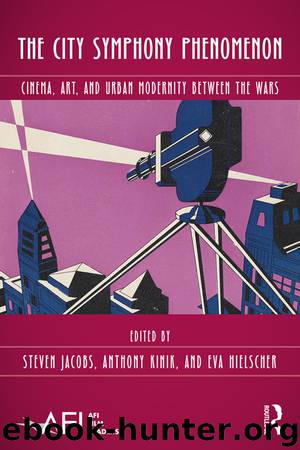The City Symphony Phenomenon by Steven Jacobs Eva Hielscher Anthony Kinik

Author:Steven Jacobs,Eva Hielscher,Anthony Kinik
Language: eng
Format: epub
Publisher: Taylor & Francis (CAM)
Published: 2018-07-02T16:00:00+00:00
Conrad’s montage follows the Soviet aspiration of not only analyzing the world but also of reaching conclusions, and his montage of written signs participates in this dual process. The message “Jesus Saves” appears four separate times in the film, always as part of the urban environment, and usually as a sign on a church or mission for the indigent. In two cases it is followed immediately by images that seem to undercut the supernatural aid the sign promises (cutting to an amputee propelling himself on a cart of the sidewalk in one case, and to a drunk collapsed on the street curb in another). The other montages are a bit more oblique, if potentially more interesting; the first “Jesus Saves” sign is followed by a sign in a meat market advertising “free souvenirs,” and the third “Jesus Saves” sign cuts first to men walking on the sidewalk and then to a billboard with a running cartoon baby proclaiming: “I got Live Power!” The promise of eternal salvation is rendered absurd through this juxtaposition to a commercial claim of super power. This recurring rerouting or undermining of written messages sets up the film’s major counter-current to the order of the depression- era city. Early in the film Conrad makes it clear that there are forces of political opposition and conflict within this city. Halsted Street shows a picket walking with a sign proclaiming “Kroger unfair to its workers.” Not only are written messages in this film to be read ironically and critically, they contend with each other. Thus, the film activates a conflict over meaning and even over the control of urban space.
But the most central visualization of this energy of conflict comes with the film’s major overarching trope which redefines the film’s most obvious structure of the one-way street: the figure I will call “the determined pedestrian.” About a third of the way into the film, and just after the billboard of the speedy baby with “Live Power,” a figure of a young man in an overcoat appears, walking with a determined pace that sets him apart from the other pedestrians in the film. He also stands out because the camera tracks along with him in his consistent right-to-left motion, sharing his sense of direction. As he recurs through the film, appearing in 13 separate shots in the various neighborhoods, he functions as a thread that links the diverse topographies. These regularly occurring tracking shots of his determined strides punctuate the otherwise unmoving shots of the film, setting up a dominant rhythm of moving and static shots. While one tends to align him with the film’s structure, with Halsted Street itself, I think that with repetition and acceleration the relation becomes more complex. Halsted Street structures this urban space; it links, but also keeps apart, the neighborhoods. This figure overcomes the distance of the street; he uses the street to get somewhere and as the film progresses, his pace actually increases, until he is running in his final appearances.
This running
Download
This site does not store any files on its server. We only index and link to content provided by other sites. Please contact the content providers to delete copyright contents if any and email us, we'll remove relevant links or contents immediately.
Kathy Andrews Collection by Kathy Andrews(11709)
Thirteen Reasons Why by Jay Asher(8768)
The Red Files by Lee Winter(3357)
How to Do Nothing by Jenny Odell(3220)
The Genius of Japanese Carpentry by Azby Brown(3209)
Stacked Decks by The Rotenberg Collection(2796)
Tattoo Art by Doralba Picerno(2582)
Champions of Illusion by Susana Martinez-Conde & Stephen Macknik(2403)
The Artist's Way Workbook by Cameron Julia(2186)
The Art of Doom by Bethesda(2098)
Calligraphy For Dummies by Jim Bennett(1979)
Creative Character Design by Bryan Tillman(1879)
Botanical Line Drawing by Peggy Dean(1800)
Wall and Piece by Banksy(1771)
The Art of Creative Watercolor by Danielle Donaldson(1767)
One Drawing A Day by Veronica Lawlor(1759)
Art Of Atari by Tim Lapetino(1682)
Pillars of Eternity Guidebook by Obsidian Entertainment(1611)
Happy Hand Lettering by Jen Wagner(1549)
